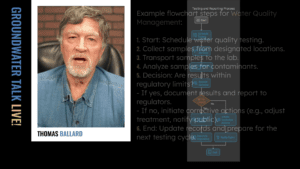Water infrastructure is a vital part of the nation’s critical systems, yet it is increasingly vulnerable to cyber threats. Whether you manage a large urban water utility or a small rural system, the risk of cyber attacks is real and growing. In this article, inspired by insights from The Groundwater Guy, you will learn practical, step-by-step strategies to safeguard your water utility against hackers, ransomware, phishing scams, and other cyber adversaries. These simple but effective defenses will help you protect not only your infrastructure but also the health and safety of your community.
Why Cyber Security Matters for Water Infrastructure
Water utilities form a crucial part of the nation’s critical infrastructure. They provide essential services that keep communities safe and healthy. A cyber attack on your water system can have devastating effects, such as:
- Shutting down pumps and disrupting water delivery
- Contaminating water supplies
- Blocking billing systems and administrative functions
- Causing public health risks and service outages
- Generating costly repairs and lost revenue
Even a small breach can spiral into a major crisis, especially for smaller water systems that often lack dedicated IT staff or robust security measures. Hackers, ransomware gangs, and even foreign adversaries are actively targeting water infrastructures, seeking ways to disrupt operations and create chaos.
Step 1: Understand the Common Cyber Threats to Water Systems
To defend your water infrastructure effectively, you need to know the main types of cyber attacks that utilities face today. These include:
- Ransomware: Hackers lock your systems and demand payment to restore access. This can cripple your operations and put your water delivery at risk.
- Phishing: Fake emails and messages trick staff into revealing passwords or downloading malicious software. Phishing remains one of the most common and effective attack methods.
- Unauthorized Access: Weak passwords or exposed devices can allow hackers to break into your control systems and manipulate operations.
- Equipment Flaws: Internet-connected devices with security vulnerabilities can be hijacked by outsiders if not properly secured and updated.
Recognizing these threats is the first step in building a strong defense. You must be proactive rather than reactive to keep your water infrastructure safe.
Step 2: Strengthen Passwords and Access Controls
Passwords are your first line of defense. Unfortunately, many utilities still use default or easily guessable passwords like “admin” or “1234.” This makes unauthorized access incredibly easy for hackers.
Here’s what you should do:
- Change all default passwords: Replace any factory-set or generic passwords immediately.
- Use strong, unique passwords for every system: Avoid reusing passwords across different platforms. Use a combination of letters, numbers, and special characters.
- Set up multi-factor authentication (MFA): MFA requires users to enter a password plus a code sent to their phone or generated by an app. This extra layer of security makes it much harder for attackers to gain access.
Implementing these measures can drastically reduce the risk of unauthorized access to your water infrastructure.

Step 3: Isolate and Secure Your Control Systems
Your control systems, such as SCADA (Supervisory Control and Data Acquisition), are critical to water operations but are also prime targets for cyber attacks. Never connect these systems directly to the public internet. Instead, you should:
- Use firewalls: Separate your office network from your operations network with firewalls to prevent unauthorized access.
- Limit remote access: If remote access is necessary, use secure VPNs (Virtual Private Networks) and strict authentication controls.
- Disable unused ports and services: Reduce the attack surface by shutting down any unnecessary network interfaces or services.
These steps help create a secure boundary around your water infrastructure’s operational technology.

Step 4: Regularly Update and Patch Equipment
Cybersecurity is not a one-time setup—it requires ongoing maintenance. Software and firmware updates often include critical security patches that fix vulnerabilities discovered after deployment. To keep your water infrastructure safe:
- Update all devices regularly: This includes computers, control system components, network equipment, and any connected devices.
- Work with vendors: Collaborate with your equipment suppliers to identify and address known security flaws.
- Prioritize security patches: Apply updates as soon as they are available rather than delaying them.
Ignoring updates leaves your systems open to exploitation by attackers who target known vulnerabilities.
Step 5: Train Your Team to Recognize Cyber Threats
Your staff is the frontline defense against cyber attacks. Even the best technical controls can be bypassed if employees fall for phishing scams or fail to recognize suspicious activity. To empower your team:
- Conduct regular training sessions: Teach staff how to identify phishing emails, suspicious links, and other common cyber threats.
- Make cybersecurity part of safety meetings: Incorporate discussions about cyber threats and best practices into your regular team meetings.
- Encourage reporting: Create a culture where employees feel comfortable reporting potential security incidents immediately.
Continuous education helps build awareness and resilience throughout your organization.

Step 6: Back Up Your Data Securely
Backing up your system data, settings, and important files is essential to recovering quickly from a cyber attack. Follow these guidelines:
- Make regular backups: Schedule frequent backups to capture the latest system configurations and data.
- Store backups offline or in secure cloud locations: Keeping backups offline protects them from ransomware that targets connected storage.
- Test your backups: Periodically verify that your backups can be restored successfully.
Having reliable backups ensures that you can restore operations with minimal downtime if your water infrastructure is compromised.
Step 7: Develop and Practice an Incident Response Plan
Cyber incidents are not a matter of if, but when. Preparing a clear, simple response plan will help you react swiftly and effectively. Your plan should include:
- Contact information: Who do you call if you suspect a cyber attack? Identify internal experts or external IT professionals.
- Operational continuity: How will you keep water flowing if your computers or control systems go down?
- Communication protocols: How will you inform staff, customers, and authorities?
- Recovery procedures: Steps to restore systems and verify water safety.
Practice your plan regularly through tabletop exercises—discussions and simulations—to ensure everyone knows their role during an incident. This preparation can drastically reduce the impact of cyber attacks on your water infrastructure.
Step 8: Stay Informed About Regulations and Resources
Cybersecurity requirements for water utilities are evolving. The Environmental Protection Agency (EPA) now mandates cyber security assessments as part of sanitary surveys for public water systems. Staying compliant and informed is crucial.
Fortunately, federal and state agencies offer free resources and technical assistance to help water utilities improve their cybersecurity posture. Don’t hesitate to reach out to these organizations for guidance, training, and support.
Keeping up to date with regulations and leveraging available resources strengthens your defense against cyber threats and helps protect your water infrastructure for the long term.
Conclusion: Building a Resilient Cyber Defense for Your Water Infrastructure
Cyber threats to water infrastructure are a serious and growing concern for utilities of all sizes. However, by taking a proactive approach, you can significantly harden your defenses and reduce the risk of disruption, contamination, and costly repairs.
Remember these essential steps:
- Understand the common cyber threats targeting water systems
- Strengthen passwords and implement multi-factor authentication
- Isolate and secure control systems from the public internet
- Regularly update and patch all equipment
- Train your team to recognize and respond to cyber threats
- Back up your data securely and test recovery procedures
- Develop and practice an incident response plan
- Stay informed about cybersecurity regulations and utilize available resources
By following these practical steps, you can protect your water utility, your team, and most importantly, your community. Start building your cyber security defenses today to ensure the safety and reliability of your critical water infrastructure.
For more detailed guidance and ongoing updates, consider connecting with experts and agencies specializing in water utility cybersecurity. Protecting your water infrastructure is not just a technical necessity—it’s a vital responsibility to public health and safety.


